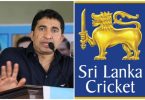Written By Sundip G At Indian Express
When Maheesh Theekshana grabbed a wicket with his first ball in international cricket a month ago against South Africa, and ended the night with four wickets piquing the inquisitiveness of onlookers with his mystery spin, his mentor Chinthaka Perera’s memory rolled down the years and stopped at a muggy Colombo afternoon five years ago.
Tugging the index finger of an elderly woman, a heavy-set teenager with bright eyes was lounging on the grass lawn that hugged the boundary line, demarcated with chalk powder that swirled in the light breeze. A group of boys dragged him, not more than 15 years old, to the tiny pitch beside the ground and threw him the ball. And then with spellbound eyes, watched him perform one trick after another with the red ball. The gathering of children, parents, and random passers-by swelled, like they do when a magician performs tricks at a local fair. Perera, too, joined them and Theekshana cast an instant spell on him too. “The skid, the skid…” Perera muttered subconsciously. “I have never seen a boy of his age purchase that much skid off the surface, and it was not even a matted wicket,” he recalls.
The action too struck—“a Xerox of Ajantha Mendis”. It was more or less self-taught — he had begun to watch cricket at the peak of Mendis-mania and mystery-spinner obsession. The coaches, as is commonplace in Sri Lanka, never bothered destroying or deconstructing it. A tweak here, a fine-tuning there, the action he acquired naturally is intact.
Gobsmacked, Perera waited for the school match to get over so that he could make a formal offer to enrol him at St Benedict’s College, for whom he was scouting. The college had not produced an international cricketer in 42 years, and a bunch of ex-students had formed a group called Kingsmen Cricket Foundation to identify talented cricketers from nondescript schools, before the big ones came bounding to snaffle them, and groom them at Sat. Benedict’s.
As it turned out, Theekshana was waiting for a break himself. The school he then studied at, Siddhartha MMV in Sedawatta, couldn’t provide the required sporting exposure. His family was not prosperous enough to send him to an elite cricketing school in the city, or an academy either. He got his initial tutoring at Asoka de Silva School of Cricket, but it had reached a stage where he needed to represent a school with a more visible presence. So Theekshana readily nodded his head though the grandmother needed some nudging. “She was worried a bit about the distance, then she would do anything to see the smile on her grandson’s face,” Perera says.
Soon she was to become a familiarly endearing presence at the net sessions and inter-school matches. Her cricketing knowledge was limited but she would do anything to see Theekshana happy. “The grandmother meant the whole world to him, and he meant the whole world to her as well. She looked after him and his two sisters with whatever little means she had. She soon became a granny for all of us too,” he remembers.
The grandson was a quiet and affable boy. “He would not waste time chit-chatting with friends. He would straightaway pick a ball and start bowling. He knew his bowling inside out and would tell us what he had and had to add. His self-awareness used to surprise us,” Perera says.
One day, he told the coaches that he wants to develop a carrom ball, the ultimate new-age weapon for off-spinners. “He already had a theoretical knowledge and wanted us to guide him. He would head to the nets and keep practising the same ball for more than an hour. He was a very driven boy, who would keep on listening to coaches,” recollects Perera.
He was a perfectionist too. “He practised the carrom ball for three years, until he fully mastered it. He didn’t try the ball even once in a school game until he was sure he could land it properly. Though they were school games, he was conscious to not waste the balls,” he says.
It applied to his batting too — he never liked wasting balls. “It’s an understated aspect of his game. He is a terrific batsman too, had won the best school batsman in Sri Lanka award in 2012. He used to be an attacking opener, before he started prioritising his bowling,” he observes.
He was so focused that Perera doesn’t remember him picking up a fight or even arguing with anyone, even in ‘who’s-better- than-who’ cricketing arguments. From a supposed project player, he became a younger brother or son-like for most coaches.
The five-year period at the college was one of vaulting progress. Thekshana’s all-round dazzle recaptured some of the old glory for the college, he grabbed the attention of the junior selectors, was fast-tracked to the national academy in Colombo, and in two years’ time wrapped the Sri Lanka jersey around him, besides getting into the Army team where he is nurtured by mystery man Ajantha Mendis himself, and earned a T10 contract.
Nothing, though, has changed in him. “He is still that quiet boy with bright eyes, clinging to his grandmother, a younger brother to all of us. He often calls us for blessings, discusses variations and spin-bowling in general. After he got the Jaffna Stallion contract, he donated a part of the match fee to the college too,” Perera says. He has not stopped spellbinding onlookers either. The crowd that swells around him when he bowls just keeps swelling as if he’s a conjurer pulling one trick after the other off his hat.
Around two years ago, the news of a young mystery spinner plucking a bucketful of wickets in school cricket reached the doors of the National Cricket Academy, inside the rambling R Premadasa Stadium. The then director of cricket, Simon Willis, and spin bowling coaches called Theekshana for a trial. Willis was pleasantly shocked. “He floored all of us, with his control, accuracy, variations and that Mendis-like action. We had no hesitation in taking him into our fold,” recounts Willis, who is now back in the UK, coaching independently after a stint with the England and Wales Cricket Board.
For first-class experience, he was put in the Colts Cricket Academy, where he impressed and stacked up numbers with both bat and ball. However, the only numbers that stacked against him were of his body. At that time, he weighed 105 kilograms, had 140 skin-folds, took 10.1 minutes to complete the two-kilometre test and his best in the YOYO test was 16.1. Sri Lanka has had its share of cricketers not in the finest physical shape, spinners especially, but in this day and age of frantic cricket, fitness is paramount.
The realisation of the need to reduce weight dawned after Theekshana was overlooked for the U-19 World Cup. “We were sure of his skills, but his fitness was dodgy. We doubted if he could take the rigours of international cricket. We dropped him for his own good,” explains Willis.
Theekshana was heartbroken, but determined. “We educated him and his parents about the dietary requirements. What often happens here is that out of love mothers and grandmothers put a lot of oil, sometimes cheap oils, in the food they make for the children. And of course, rice too. But Theeskana took it positively and worked really hard on it,” he says.
For months, he cut rice off his diet, chopped off fried fish and snacks from his life, and ran lap after lap around the Premadasa. “Whenever I called him, he would not pick up the phone, and would later tell me that he was running or exercising in the gym,” says Perera. The results were staggering. “Each time I saw, he looked fitter and fitter, dropping at least five kilos each time,” he says.
By 2020, Theekshana had dropped 22kgs; more importantly, halved his skin-folds, improved his YOYO test maximum to 19.2 and dropped the two-kilometre sprint time to 8.28 minutes. “I was super-excited to see the result of the hard work the young man had put in. It’s this determination of his that could make him a better cricketer,” observes Willis.
Like he was at the St Benedict’s College, Theekshana became popular at the academy too. “He was a hit among the senior players too, and they would gift him a pair of shoes, like Thisara Perera, or a new bat, or a cricket gear while the coaches sometimes took care of his financial aspect. Every one of us wanted to see him grow and play for Sri Lanka one day,” says Willis.
None of them touched his action. Or the methods. “It’s the biggest coaching lesson I got from Sri Lanka. Do not bother changing the natural. Rather polish it. Coming back to England, I tell all the coaches I know to not change what is natural. There are merits of unstructured coaching and I show them the example of Ajantha and Maheesh,” he says.
It’s not the first time, nor would it be the last, when Ajantha and Maheesh would be bunched in the same sentence.
Their similarities are irrepressible. Like Mendis, Theekshana stands at the end of his run twirling the ball, breaks into pitter-patter strides, gripping the ball like a seam bowler would in the tips of his fingers, and releases it in a brisk and smooth forward thrust with no jerk or clutter. Like Mendis, his non-bowling hand reaches upwards just before delivery, the index finger on that hand points skywards as if in premonition that the umpire is about to give the batsman out.
He experiments with several grips. The standard off-break is delivered with the index finger and middle finger spread across wider than more conventional off-spinners. Hence, a lot of thumb, too, goes into the ball, and he bowls both with the upright and scrambled seam. For the carrom ball, he spreads those fingers — the thumb acts as a backrest, the forefinger as the axis and the middle finger for flicking the ball in an anti-clockwise direction. A carrom-ball-like grip is used for the slider too, though he doesn’t flick the ball as hard as he does a carrom ball. The googly is, of course, delivered from the back of the hand with a slightly tilted seam and with more wrist into the ball. The arm-speed is slower than for his off-break staple, the ball is tossed up more and it turns more than the googlies of, say, Rashid Khan.
This variety is accompanied by unerring accuracy. Basically, whatever he bowls, he bowls at the stumps, forcing batsmen to play.
The unprecedented attention on Theekshana had Sri Lanka coach Mickey Arthur worried if he had exposed his trump card too early. He implored broadcasters to not dissect him too much. “Can we hang on analysing him too much before the WC, please!” he tweeted.
But his skipper Dasun Shanaka sounded out a warning to potential adversaries. “It’s not easy to read him because he’s now got the googly, and the carrom ball, and his off-spin as well. Because he’s got several variations, I don’t think it’ll be easy for any team to read him. It’s not just how difficult it is to read him, we also know that he’s a skilful bowler.”
This is perhaps the legacy of Mendis too, even if his career languished unfulfilled, more due to injuries than the ebbing of mystery. He has inspired a generation of mystery spinners, encouraged experiments with grip, seam-manipulations, and release, and expanded the horizons of spin bowling. And to those that think that the lineage of mystery spinners is successor-less in Sri Lanka, Willis counters: “Just watch a school game. You could pick as many as you want.” Perera agrees and turns philosophical: “For us, perhaps, mystery spinners are the orthodox ones and the orthodox ones, mystery spinners.”
Whatever the definition and perception of mystery is, Theekshana now has the cricket world around him as spellbound as the kids around him on that sun-parched afternoon in Colombo when Perera first cast his eyes on him.







